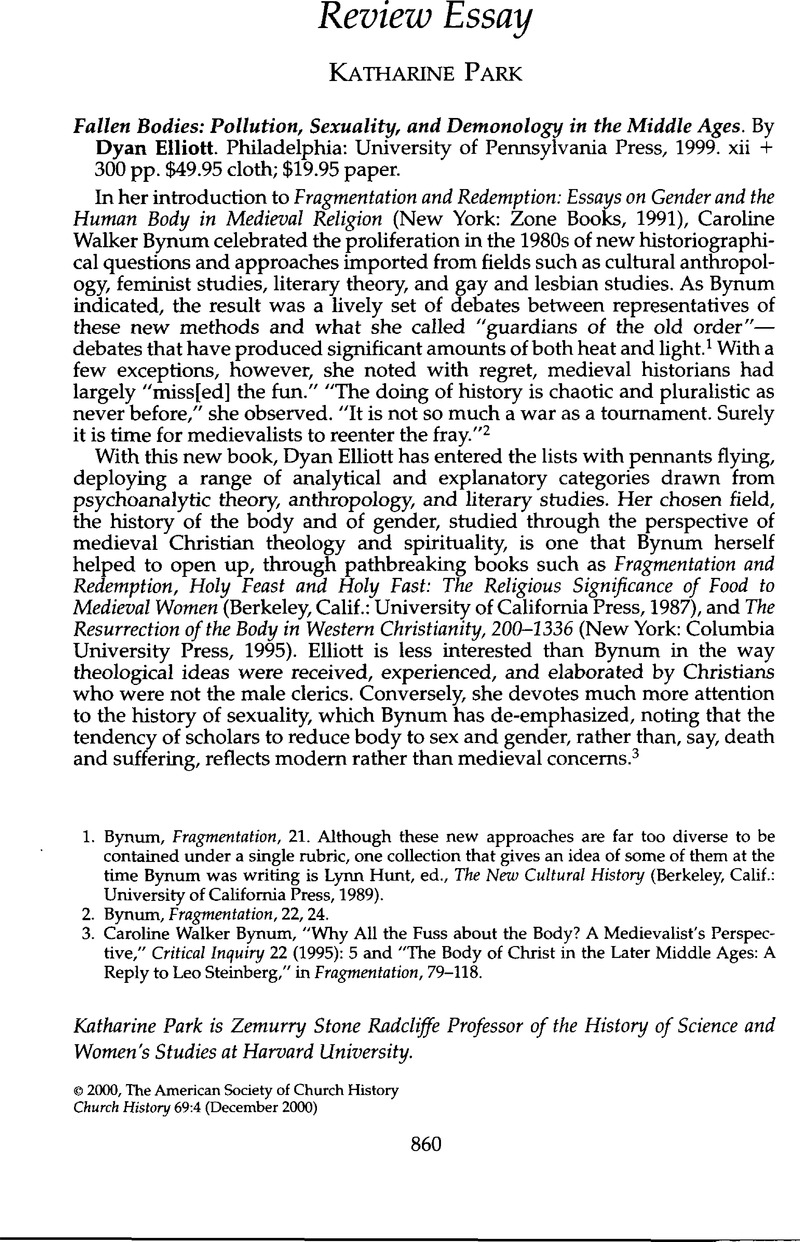No CrossRef data available.
Article contents
Fallen Bodies: Pollution, Sexuality, and Demonology in the Middle Ages
Published online by Cambridge University Press: 28 July 2009
Abstract

- Type
- Review Essay
- Information
- Copyright
- Copyright © American Society of Church History 2000
References
1. Bynum, , Fragmentation, 21. Although these new approaches are far too diverse to becontained under a single rubric, one collection that gives an idea of some of them at thetime Bynum was writing is Hunt, Lynn, ed., The New Cultural History (Berkeley, Calif.:University of California Press, 1989).Google Scholar
2. Bynum, Fragmentation, 22, 24.Google Scholar
3. Bynum, Caroline Walker, “Why All the Fuss about the Body? A Medievalist's Perspective,”Critical Inquiry 22 (1995): 5 and “The Body of Christ in the Later Middle Ages: AReply to Leo Steinberg,” in Fragmentation, 79–118.CrossRefGoogle Scholar
4. For a bibliography of works in the field before 1990, see Salisbury, Joyce, Medieval Sexuality: A Research Guide (New York: Garland, 1990)Google Scholarand Green's, Monica useful review essay, “Female Sexuality in the West,” Trends in History 4 (1990): 127–58.CrossRefGoogle Scholar
5. Each essay contains a comprehensive bibliography.Google Scholar
6. The single exception is Elliot's brief and rather cryptic mention of possible sexualanxieties raised by the doctrine of transubstantiation, according to which the Eucharistinvolves “a male cleric handling the body of a male God” (34).Google Scholar
7. For an overview, see Veeser, H. Aram, ed., The New Historicism (New York: Routledge,1989),Google Scholarand Veeser, H. Aram, ed., The New Historicism Reader (New York: Routledge, 1994), especially Veeser's introductions to these volumes. In its use of case studies andanecdotes, new historicism has strong affinities with the historiographical strand knownas microhistory, which Elliott embraces in her introduction;Google Scholarsee Elliott, , Fallen Bodies, 11.Google Scholar
8. Jordan, , Invention of Sodomy, 156.Google Scholar
9. Jordan, , Invention of Sodomy, 163;Google Scholarsee also Foucault, , History of Sexuality, vol. 1. Jordancapitalizes Sodomy and Sodomite throughout to emphasize the constructedness of thecategory and its complicated relationship to the biblical story that served as the corearound which it was elaborated.Google Scholar
10. See, for example, Partner, Nancy F., “Did the Mystics Have Sex?” in Desire and Discipline:Sex and Sexuality in the Premodern West, eds. Murray, Jacqueline and Eisenbichler, Konrad(Toronto: University of Toronto Press, 1996), 296–311,Google Scholarand Fradenburg's, Louise O. detailed review essay, “We Are Not Alone: Psychoanalytic Medievalism,” New Medieval Literatures 2 (1998): 249–76.Google ScholarBloch, R. Howard criticizes the utility of psychoanalyticaccounts of misogyny for medieval scholarship in Medieval Misogyny and the Invention of Western Romantic Love (Chicago: University of Chicago Press, 1991), 78–79. For a livelydebate on the utility of psychoanalytic theory to medieval feminist scholarship, see thearchives of medfem-l@u.washington.edu (May 12–20,1999).CrossRefGoogle Scholar
11. Anxietas does not figure as one of the six types of fear in the most common medievaltypologies of this emotion;Google Scholarsee, for example, Magnus, Albertus, bono, De, eds. Kühle, Henricus, Feckes, Carolus, Geyer, Berhardus, and Kübel, Wilhehnus, 3.5, in Magnus, Albertus, Opera Omnia, vol. 28 (Cologne: Aschendorff, 1951), 201–206Google Scholarand in general, Daston, Lorraine and Park, Katharine, Wonders and the Order of Nature, 1150–1750 (New York: Zone Books, 1998), chap. 3.Google ScholarOn the general historicity of the passions, see Daston, and Park, , Wonders, chap. 8, and Davidson, Arnold I., “The Horror of Monsters,” in The Boundaries of Humanity, eds. Sheehan, James J. and Sosna, Morton (Berkeley: University of California Press, 1991), esp. 36–37.Google Scholar
12. Douglas, , Purity and Danger, 1–5,37.Google Scholar
13. Jordan, , Invention of Sodomy, 175.Google Scholar




